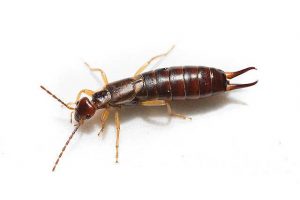
And they came to this conclusion when they noticed that the child has small bites, which he combes.
But the conclusions were premature, since they were not mosquitoes at all, but two-tails.
It turned out when they noticed their presence with their own eyes. If you still doubt whether the two-tails bite or not, I recommend that you read the following information.
The content of the article:
Is a double-tail (earwig) dangerous for humans
Each person shuddered at least once in his life when he saw a deftly adolescent insect with two frightening tails. The official name is Earwig or Forktail.
The individual has an elongated brown body, six legs, antennae and two chitinous outgrowths forming a pseudo-tail. In fact, these are the tserki with which the forktail keeps prey when eaten or uses them to hunt small insects.
The danger of a double-tail for humans
An earwig is not dangerous for a person. She has no dangerous poison. All that this creeping predator is capable of is an unpleasant pinch or bite during danger (two-tailed bites are jawed and tweaked by churches).
For an adult, such an impact will remain without consequences, but a child can scare and bring to tears. For people with allergies, a strong pinch of the double-tail can cause some inconvenience (redness, itching, small vesicles at the site of the bite).
It is necessary to treat the wound with any disinfectant and take a tablet of antihistamine medication. As for the mythical horrors about the ability of the fork to crawl into the human ear, live there and lay offspring - this is nothing more than village horror stories.
In addition, like all the insects, the forks crawl everywhere and are capable of transmitting various infections on their paws. Earwigs love moist, cool places, so in the house they can be found in bathrooms, basements and just in damp rooms with poor ventilation.
The easiest way to prevent the capture of the territory with forktails is to keep the house in order, but if insects have entered your house, decisive measures must be taken.
Ways to fight
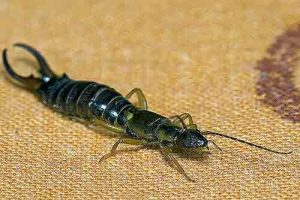
Wet rags, spread out in the habitats of the forks, will attract them to themselves, after just shaking the rags out on the street.
Earwigs do not tolerate some odors (vinegar, garlic, wormwood, tansy, the smell of laundry soap). It is worth processing the favorite places of insects (cracks in the walls, skirting boards, floors) with odorous substances, and the earwigs themselves will leave the human home.
Good results in the fight against forked tails showed the preparations Fufanon, Tiuran, Iskra, even the well-known Dichlorvos can help in the fight against double-tailed insects. The main thing is to strictly follow the manufacturer's instructions and to prevent the ingress of toxic substances into the human body.
Earwig (double-tail) common and coastal
I'll start with two terrible revelations. Firstly, an earwig is not the same as a two-tailed one. That is, in our understanding, they, of course, are one and the same thing, but, turning to Wikipedia, we find that two-tails are completely different tiny creatures that inhabit the soil.
However, for the sake of search relevance, I will also have to use the term “double-tail” to denote earwigs. The second terrible fact about earwigs is that, it turns out, they can fly. True, they resort to this opportunity extremely rarely, as well as, for example, cockroaches (yes, yes, they also fly!).
The name "earwig" itself is already terrifying, and, given that most people are afraid of insects, per se, the presence of the words "ear" and "twirl" in the name no longer causes just horror, but panic horror (just imagine ...) .
So here. Earwigs are not intended to creep into someone’s ears. However, no one is safe from discovering various creeping creatures in the ears and the risk of this unpleasant event cannot be discounted. If you want horror stories, then read the comments here on this article, they freeze blood.
In my opinion, the version is quite plausible that in some ancient times, in a certain kingdom, in a certain state, where people lived in unsanitary conditions along with fleas, lice and earwigs, cases of getting two-tails in their ears regularly took place, and the fear of this unpleasant phenomenon eventually embodied in the popular name "earwig", as it were already a warning without any further explanation.
Squad of winged bugs or earwigs
So, earwigs or bugs are a whole squad that includes 1967 species. The front wings are short elytra, under which the webbed wings, adapted for flight, are folded. There are wingless types of earwigs.
The main characteristic feature is the tail processes (cerci), which form chitin forceps, which the earwig can use to defend, attack and move objects. Earwigs prefer moist, warm places; they lead a lifestyle, mainly, at night.
They are not picky about food, eat almost any leaves, fruits and organic residues, and can easily hunt for the appropriate size of insects. There are also a number of species that lead a purely predatory and parasitic lifestyle, but this is not with us. Well, now about the most common representative of two-tails:
Common earwig (Forficula auricularia)
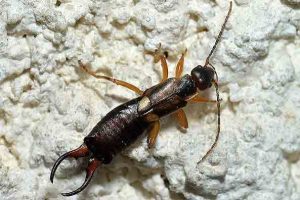
the head is reddish brown
chest and legs are light brown,
the abdomen and cerci are dark brown, almost black.
Body length up to 3 cm.
Distribution area - everywhere.
Classification (Wikipedia):
- Type: Arthropods
- Class: insects
- Squad: winged-winged (Dermaptera)
- Family: ear hooks (Forficulidae)
- Genus: Forficula
- Species: Forficula auricularia
During the day, hides in dark, damp places, under the bark of trees, under objects lying on the ground.He loves various dirty rags, especially working gloves left in the garden (be careful when putting on gloves - shake out earwigs, especially if you suffer from insectophobia).
Earworms begin to reproduce in late summer and early fall. To lay eggs, the female digs a mink, about 10 cm deep, where she hibernates, covering her future offspring with her body and protecting him from possible encroachments of other insects, including her relatives and her own male.
Due to food preferences, the earwig is a pest, however, in my memory, no noticeable damage from them was observed. As usual, it all depends on numbers and crowding.
It is also known that earwigs can climb into bee hives, where they quietly live in insulating material and various crevices, eating honey, bee bread and even bees (according to Wikipedia). The latter makes me vague doubts, somehow I can not believe that the earwig can cope with a bee. Rather, we are talking about bee larvae.
Coastal earwig (Labidura riparia)
It differs from the earwig of the ordinary, mainly in color and habitat, although it belongs to another family. Distributed everywhere. As the name implies, it is found on the shores of water bodies (both fresh and saline), preferring sandy and sandy loamy soils.
Classification (Wikipedia):
- Type: Arthropods
- Class: insects
- Squad: winged-winged (Dermaptera)
- Family: Labiduridae
- Genus: Labidura
- View: Labidura riparia
The body shape from the earwig is practically the same. The color is lighter. Young individuals are light brown, merging with the sand. In adults, black and orange elements appear in coloration. Cerci are beige at the base, dark brown at the ends.
Personally, for the first time I had to encounter a coastal earwig on the western coast of Crimea on the Bakal Spit. They accompanied us all evening, ate with us at the same table, some dragged pasta with them, holding them in high raised churches.
Subsequently, the erring two-tails periodically suddenly popped out of things for several days of travel.
Facts About Two-Tails (Earwigs)
Is it true that earwigs damage a person’s brain? Let's find out some interesting facts about the earwig.
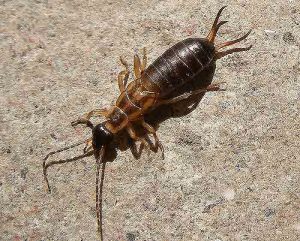
If we knew the facts about the earwig, it would be clear to us whether this is true or just a delusion. Earwigs belong to the order Dermaptera and the type of arthropod.
Earwigs are narrow, flat and long insects that can grow up to 3.8 cm. They have six legs, antennae, claws, tongs and can scan very quickly. So let's see the world of insects and get to know them better.
The most important fact is that earwigs do not penetrate the human ear and do not cause brain damage, this is just an old myth. They enter homes only in search of food. They are very difficult to find in the house during the day, they come out only when it is dark.
They are most commonly found during the rainy season, as the soil is exposed to moisture. Earwigs consume only plants, decomposed organic matter and insects, which is the main reason why they live in gardens and tree hollows.
Interesting facts about the earwig:
- In many places around the world, they are also known as earwigs.
- Records show that there are about 2,000 different types of earwigs in the world and about 22 types are found only in the United States.
- Only some types of earwigs have wings and are able to fly.
- Their skin texture is very smooth, and in most cases they are masked.
- The earwig is dark brown, while the predatory earwigs are mostly bright and attractive colors.
- During the winter, they dig into the ground at 1.8 - 2.1 meters to survive the drought.
- Female earwigs lay up to 50 eggs at a time.
- Earwigs are not harmful and not all poisonous, they can sting, but only as a last resort, as self-defense.
It is very rare to find earwigs in a house, they can penetrate your house only when it is wet or unhygienic, they do not penetrate into bedrooms, since it is mostly dry there. Earwigs are known to penetrate kitchens, toilets, bathrooms and basements, as these places are usually wet.
You can use boric acid powder, as this can help get rid of earwigs. Vinegar also helps in the fight against earwigs, but it does not completely kill them. If they are really stubborn and you are not able to get rid of them, you can call the pest control service.
In case you have been bitten by an earwig, immediately wash the bite site with soap and use disinfectants. However, an earwig bite may not always lead to infection or infection, and over time it heals.
Once you have learned all the facts about earwigs, it may be easier for you to deal with them if they visit you in the future.
Does a two-tailed man bite and why is it dangerous
Earwigs are insects. To date, more than 1700 species are known that can be found all over the world and for all of them I will have characteristic formations on the back of the abdomen in the form of “ticks”, expressed to varying degrees from species to species.
Here they easily penetrate through the holes in the walls and crawl in search of a better life in the kitchen, bathroom, garages and basements. It should be noted right away that these insects are random guests here - they are not trying to get comfortable in a wardrobe or under a mattress.
As already noted, they got into the living quarters absolutely by accident, and if the insect is not disturbed, it will go away by itself. Among other things, earwigs can also be found on farmland and home gardens where they do little harm by eating tender juicy stems and roots of young seedlings.
The information will be interesting to all our readers who want to learn more about double-tails.
Are double-tails dangerous to humans - interesting facts about earwigs
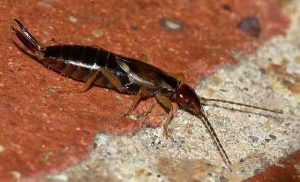
Further down the text, we will still use the term “double-tail”, considering it to be common. Earwigs are the slowest eaters when compared to other insect species of the same size.
In addition, they are omnivorous and, as a rule, eat at night. These insects eat like plant products, for example, leaves, fruits, flowers and, of course, moldy fungi, as well as insects, including pest species, which are of great benefit in the garden.
The fact that the oral apparatus of the earwigs is able to chew on food allows them to eat fairly tough foods, for example, grind the protective chitin cover of insects or the hard shell of the fruit.
Earwigs are perfectly armed with blank “cartridges”. Each of us has seen earwigs. These are long, flat, narrow dark brown, black, reddish or yellowish insects. They are large enough - their length can be from 0.5 to 3 cm, depending on the specific type and stage of the life cycle.
Like all insects, they have six legs and a pair of antennas. Some species also have wings and are able to fly, but they do this very lazily and rarely. The bodies of the earwigs are divided into three sections.
At the end of the body, on the abdomen there is a set of “tools” called - cerci, which look like mites used by insects to catch prey or for defense. You can understand what is at stake if you try to pick up an earwig with your bare hands.
Males possess curved “tongs” toward the center, while the “arms” of females are straight. Another form of protection is the tan liquid that the earwigs exude. Although it smells rather unpleasant - in fact, it is absolutely harmless.
An adult female earwig usually produces two batches of round, cream-colored eggs each year. Each batch includes up to 80 eggs. One of the most exciting facts is that an insect only needs from 20 to 70 days to turn from an egg into a fully mature individual.
The exact time depends largely on the ambient temperature. Female earwigs are beautiful mothers. Of all the facts, the most interesting is that the female earwigs show signs of maternal instinct, about which almost nothing is heard in the world of insects.
Usually by the time 2-3 molts, young individuals can already find their own food and take care of themselves, so the mother’s attention is gradually reduced. Earwigs winter in living quarters. Insects tend to live in dark, humid environments.
They can often be found in large quantities under logs, leaves, in compost, but most of them - in the crevices of the damp foundation of private houses. If there is no opportunity to take refuge closer to human warmth, they are able to bury a couple of tens of centimeters to a depth to avoid cold.
Insects enter houses, crawling through cracks in the walls, and, as a rule, prefer moist and dark places, for example, kitchens, bathrooms, garages and cellars. Earwigs are easy to get rid of.
Insects love to hide under the vegetation, so first of all you need to get rid of any piles of mown grass, leaves, compost and other organic matter around the outer walls of the apartment building. Earwigs enter the living room, crawling through cracks in the wall and foundation, so you need to make sure that all such “gates” are sealed.
In addition, any leaks should be checked and corrected, since as a result of the development of dampness, the total number of insects will only increase. Few people know, but if you replace all the white bulbs with yellow, the earwigs will be much smaller, since the yellow light of weak incandescent lamps is less attractive to insects than bright white light.
Birds and frogs are natural predators of earwigs, so it’s worth getting a few birdhouses.
Can a double-tail bite a person? Although insects can look very intimidating with their “tongs," they are generally completely harmless. The only danger for people is related to the potentially possible invasion of insects on crops, flowers and other plants that are grown in spring on the windowsill in the form of seedlings.
In fact, earwigs are quite useful because they feed on other, more harmful insects. If the earwig is found indoors, you can be sure that these insects do not breed inside. They are just looking to eat something here.
Ear bites are not contagious or poisonous. Indisputable facts indicate that these insects are basically harmless, but they are able to use their “ticks” to reward a person with an unpleasant “bite” by them, in self-defense.
The question is often asked - do double-tails bite?
They do not bite in the general understanding of this process, but can pinch with their ticks.
The next question is what does a double-bite bite look like?
If the insect was large enough, with its sharp “branches” it can pierce the skin, leave a trace of two points on it with redness in the middle. Small individuals may not leave any traces at all.
Earwigs often move with a person. One of the no less interesting facts about earwigs says that these insects are able to travel with people over fairly long distances. Insects rarely fly, and they are not able to crawl quickly and far.
However, they were able to quickly spread throughout the dry part of our planet through human activities.
Therefore, if you plan to move from an apartment rich in the presence of earwigs, you should carefully review your luggage for the presence of peculiar hitchhikers. To conclude this material, I would like to share the most intricate fact about these living creatures.
Different peoples have the same myth that makes those who believe in it not sleep on the ground or floor. An earwig is able to creep into the ear, lay eggs there, from which subsequently hatched larvae will slowly gnaw through the tunnels in the direction of the brain, causing the victim to go crazy.
You can’t act on the insect with any tool - trying to protect itself, it will necessarily pinch with its ticks, which will cause a lot of trouble. If the insect does not crawl out by itself, it can be washed out from there with a stream of warm water using a volumetric syringe Janet, for example. Take care of your ears and seedlings, and do not be afraid of earwigs - it is absolutely harmless.
Who is a double-tail?
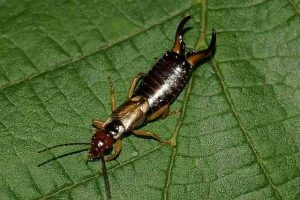
They are called double-tails for their specific appearance - and indeed, in the back of the insect are two sting-like tail probes.
Therefore, sometimes they are called colloquially with tweezers. Is that why the popular belief that a two-tailed bites ?!
To begin with, we will understand - the official name of such an insect is an ordinary earwig. It belongs to the order Skin-winged, has facet eyes, mouth organs directed forward, and a pair of antennae.
The body of the insect is elongated: it has tongs at the end, but its wings are short. She has nothing to do with real two-tails, but for some reason it is customary for us to call this creature that way. Why is it still believed that the two-tailed bites?
Mainly because of its appearance - this insect does not belong to the category of beautiful ones. Moreover, for many it causes only disgust. Because often parents in childhood tell their children that the two-tailed bites so that the child does not reach for such an eerie insect, and even more so did not seek to bring such a pet from the street to the apartment.
Does she bite?
But in adulthood for many, the earwig and its imaginary bites are a clear example of the proverb that fear has large eyes. It is not uncommon among summer residents and vacationers to talk about the giant blisters that supposedly left a two-tail on the body, the bite of which is painted almost as deadly.
If you see a trace of it in the photo, then it looks really creepy. But if you delve into the essence of the matter, it will actually turn out that actually the two-tailed bite is extremely rare and completely painless.
Earwigs are not predatory insects. Their mouth organs are not meant to bite people. In nature, these insects live in gardens and are fruit and vegetable pests. They gnaw leaves, fruits, flowers and unripe seeds of plants.
It is also not uncommon for earwigs to live in apiaries or in forest hives. There they settle in the inter-wall space or in the material insulating the hive and feed on honey, bees and bee bread. This, incidentally, is sometimes the cause of an allergic reaction of a person to an earwig.
Do not try to get rid of him, unless you "avenge" the spoiled crop. Just try not to pay attention to it, drive it away from the body if it has climbed onto your leg or arm. Remember that the only correct answer to the question of whether the two-tailed bites is, of course, negative.
What are the danger of two-tails in the house
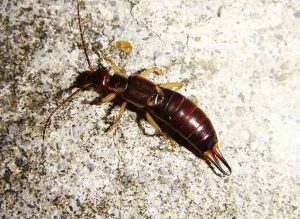
They are popularly called fork-tails, earwigs or the familiar word two-tailed. For many people, they disgust their appearance.
You can get a forktail in the neighbors if you do not follow basic hygiene rules and if the house is damp. Two-tails in the house are activated at night, their main habitat is dark and moist snouts.
In the comfortable apartments of the city, these insects are rare guests, many people did not even see them in their eyes. But in rural homes and cottages, residents often meet with them. The main condition for breeding double-tails is the fight against dampness. Then the prospect of earwigs in your home drops sharply.
Two-tails in the house - for a person’s health, the earwig does not pose any particular risk, there is no poison in her bite. However, it can bring tangible harm.
- Two-tails bite painfully. Tiny wounds form in bitten areas. They begin to itch like mosquito bites. The damaged part of the body swells and turns red.
- There are cases of an allergic reaction to a bite. Then a watery bladder may appear at the site of the wound, which will burst over time and will hurt.
- An infectious virus can enter the body through the affected area and enter the bloodstream. Two-tails, like other insects, are carriers of a wide variety of infections.
- Big tails can cause tails if they manage to creep into a person’s ear at night when he sleeps. The eardrum can be injured, leading to the onset of the disease.
- Earwigs harm both garden plants and indoor plants. They feed on the leaves and fruits of crops. If a lot of double-tails have divorced on your site, then you risk losing your crop.
Nevertheless, these insects bring little benefit. Two-tails in the house often fall in love with places where small ticks and spiders gather. If you managed to make yourself these lovely neighbors, then the two-tails will deal well with them.
They eat both plants and small insects. Despite this circumstance, if you find a double-tail in your house or on a plot, proceed immediately to get rid of these pests.
You can avoid increasing the number of earwigs in case you keep order in your yard and garden. Clean all rubbish in time: torn weeds, various twigs, food leftovers and the like.
Forktail will definitely visit these places, where they can simply be filled with boiling water. Two-tails in the house - in exceptional cases, start using insecticidal chemicals such as phenaxin, tarax, carbafos, fosbetsid, raptor and others.
Carefully read the instructions for use, because these are dangerous toxic poisons.
We had two-tails in our private house, but I never thought that they could be dangerous? We had few of them and therefore there was no reproduction, we just managed to treat them with a simple spray purchased in a garden store during the time. The seller advised us, what you need to buy. If you immediately eliminate them, then I thinkthere will be no problems. Better, really ask the consultants. what exactly you need to buy!
I would not say that these two-shaft are so harmless. They can quietly get into the pan with food and then we will see spoiled foods. So, with such insects it is necessary to deal with all available methods.
No ... I understand everything - where they can come from in a private house is clear. But where do they come from in the apartment? This is not a cockroach, which you can accidentally bring with things. Especially considering that there is nowhere especially. I caught them many times in the bathroom. Units rarely. But still caught. It turns out that they do not disdain concrete and plastic and live. It would be damp and warm.
It says here that the ability to creep into the ear at the earwigs is a myth, but I personally know the case when this happened. It is not for nothing that she has such a name, and only urban people can not believe it, village ones should not be convinced of the opposite, since many are sure of this and not in vain. It can really creep into the ear, because for it the auricle is like a mink, and the heat and dampness inside cause the insect to seek food. The tympanic membrane becomes food and the two-tailed gnaws it, it was just such a case in my memory.
There is sulfur in the ears and it repels insects